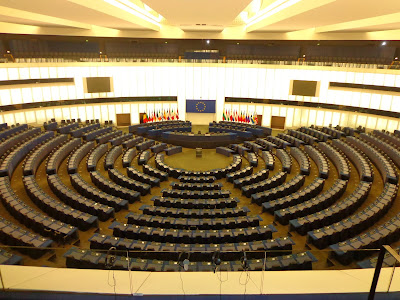Last month I got a new subject in my class about EU Environmental Law. The class is only 5 days long and taught by a German lawyer from University of Münster. On that class we had some introduction material about European Union (EU). The history of how the Union was created, the Treaties of EU, the organs of EU, the decision making process, etc. What is more interesting is that we also get a chance to visit the
European Parliament Building here in Strasbourg. Strasbourg is a city located in the boundary between France and Germany. They said that it was build purposely on Strasbourg as a symbol of peace between France and Germany who used to war.
The European Parliament is one of the EU organs which act as a representation of Union citizens. There are currently 766 Members who represent the EU's 500 million citizens.
They are elected once every five years by voters from across the 28
Member States. The number of representatives are based on the number of the citizens of the corresponding state. For example, German the country with the highest population in Europe has the most representative, while Malta, the smallest one only have 6 representatives.
As a representative of all European citizens, the assembly's
multilingualism has become one of its most important aspects.
Therefore Parliamentary documents are published in all the official languages of
the EU member states and every member of European Parliament can speak in their own official language and the listener will listen to the real-time translation from the translator who sit on the back side of the assembly hall.
The seating arrangement on European Parliament is divided based on the parties, each with different color. For example, The European People's Party are in blue, Progressive Alliance of Socialist and Democrats are in red, Alliance of Liberal and Democrats for Europe are in yellow, European Free Alliance are in green. As a legislative body of EU, the European Parliament has some powers including (1) legislative power: law making procedure, (2) budgetary power: adoption of EU budget, (3) supervisory power: oversight over other institutions, monitor and control the proper use of EU budget, ensure the correct implementation of EU law, (4) relation with other national parliaments: The European Parliament keeps the Member States’ national parliaments regularly informed of its activities.
 |
| Outer look of European Parliament Building |
 |
| The Spiral Staircase |
 |
| The Assembly Hall |
 |
| Flags of European Countries |
 |
| The Hall | | | | | |
|
|
|
|






No comments:
Post a Comment